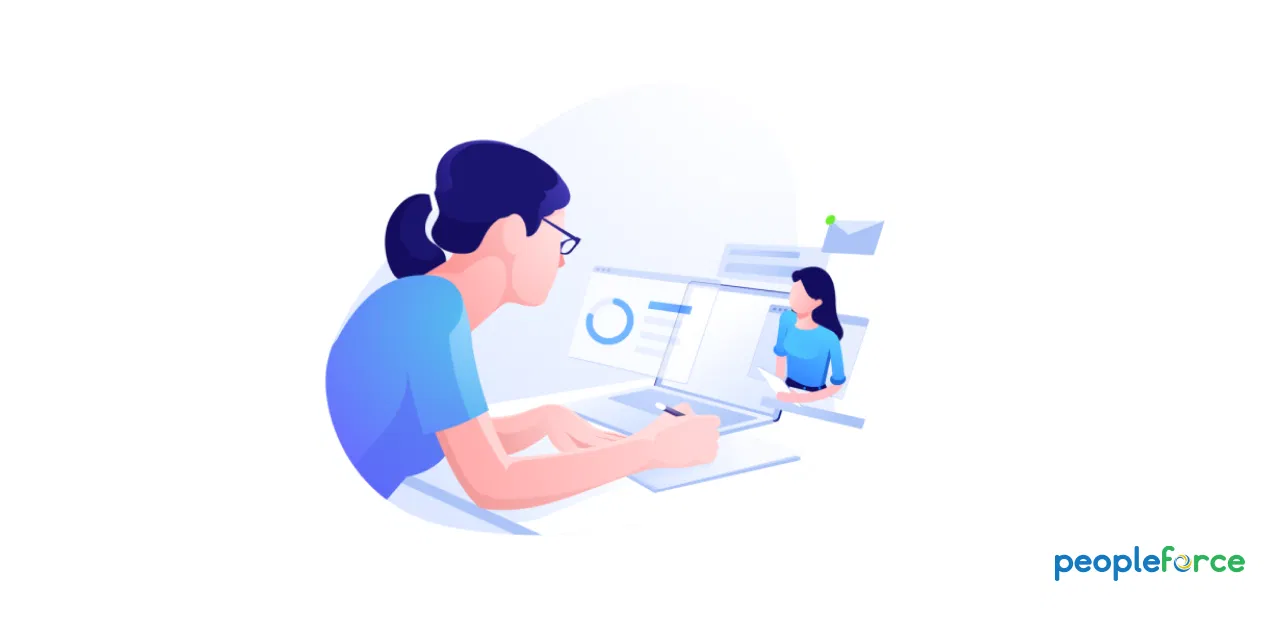
Employee Onboarding and Adaptation in conditions of remote work
In recent years there has been a disruptive shift in the way people work. Moving from the physical presence of people in the office to a remote working model is presenting itself as an opportunity for both employees and companies. Employees enjoy a better work-life balance and companies, in turn, reduce their operating and administrative costs. Increasingly, this model is attractive to a growing number of companies. Companies can now even choose to adopt hybrid schemes according to their needs and possibilities.
What is clear, however, is that the greater the employee engagement and employee satisfaction with the company, the better the results achieved in any work scheme. Recognising that successful employee onboarding is a key objective in achieving that engagement, invites the challenge of having a hiring process that allows employees to adapt to the change that has come to take place in the digital age.
The key question is, what processes, techniques and onboarding tools can be adopted to achieve this?
Why is the onboarding of remote workers important?
First of all, what is employee onboarding? It is the process of integrating a new employee into the company and the team, which starts at the time of hiring and lasts up to six months, and sometimes even longer, depending on the employer onboarding experience and company culture. The stages of new employee onboarding can be divided, for example, as follows: pre-onboarding, first week, first month, three months, etc.
Each of these steps aims at getting a first positive employee experience, getting to know the corporate values and objectives, comparing expectations and actual responsibilities, among others. In other words, it is a wide range of actions during a new onboarding process, which, if taken correctly, the new hire will be successfully integrated into the team and will be as productive as possible for the company.
Approximately 88% of organisations worldwide are not yet developing their onboarding programs. According to Gallup research in 2020, only 12% of employees surveyed agreed with the statement that they are completely satisfied with the entire employee onboarding process. Digitate has been studying the processes of engaging new employees in teamwork since 2016 and, according to them, 1 in 5 new hires are not ready to recommend an employee, precisely because of the lack of communication in the first few weeks.
According to Gallup, if employees don't see their reasons for employment being fulfilled in the first month of employment, they are almost certain to start exploring other options and a poor image of the company will prevail in their minds during their tenure. Now, in the age of remote working, leaders need more than ever to support the onboarding experience to get new hires on board and become productive team members.
The first days on the team define the first 3 years of work
Meanwhile, according to Glassdoor, an effective onboarding process increases employee retention by 82% and efficiency by 70%. The study by Dr Tayla Bauer, who writes for the SHRM blog, was conducted in 2019-2020 with the University of Oregon. Of the 1,000 employees surveyed, 69% said a comprehensive onboarding program kept them at the company for at least 3 years.
It is easier to build an onboarding process when you can have personal contact in an office environment as the person can directly observe the relationships within a team, attend meetings, meet people and be constantly navigating a new environment without leaving the team. But what about remotely? Companies with a well-developed culture were the first, from 2020 onwards, to start giving clear instructions and preparing checklists to guide the remote onboarding process and adaptation. The beginning of everything is in the first stage: pre-onboarding.
Employee Onboarding is a fundamental part of the new hire experience in the company. The most important thing is that they feel that the promises made to them during the recruitment process are kept. In this way they can be prepared to perform at a high level. When everything is done well, employees develop engagement and learn what defines their success in the company.
Pre-onboarding that you should not forget about
The stage after the final interview, but before the new employees joins the job, is called pre-onboarding. It is important to work clearly through all stages of pre-onboarding so that the new hire feels supported.
Stages of pre-onboarding
- Welcome letter
After accepting the offer, send the employee a welcome letter stating:
- probationary period and its conditions
- start date
- supervisor/mentor contacts
- departmental contacts and direct managers
- HR department contacts
If the induction involves getting to know a company's products, services or systems, please attach a welcome presentation about the project to the email.
- Welcome-book
"Welcome-book" is a very good tool for an employer who is concerned about employees entering a vacancy remotely. The welcome-book is a detailed instruction with:
- the mission and values of the company
- its history, company policies and organization's culture
- vacations and public holidays policy
- standards of conduct and dress code (if applicable)
- joining and leaving information
- contacts, etc.
- A note about the new employee in the general company chat or email
In the note that the team will receive, you should briefly talk about the person, and share possible hobbies, photos and contacts to create a working connection.
- Sending a welcome-kit
During onboarding, great companies care about a new employee's workplace. They offer a laptop, and equipment, and send nice small gifts like branded clothes, a badge, and a notepad.
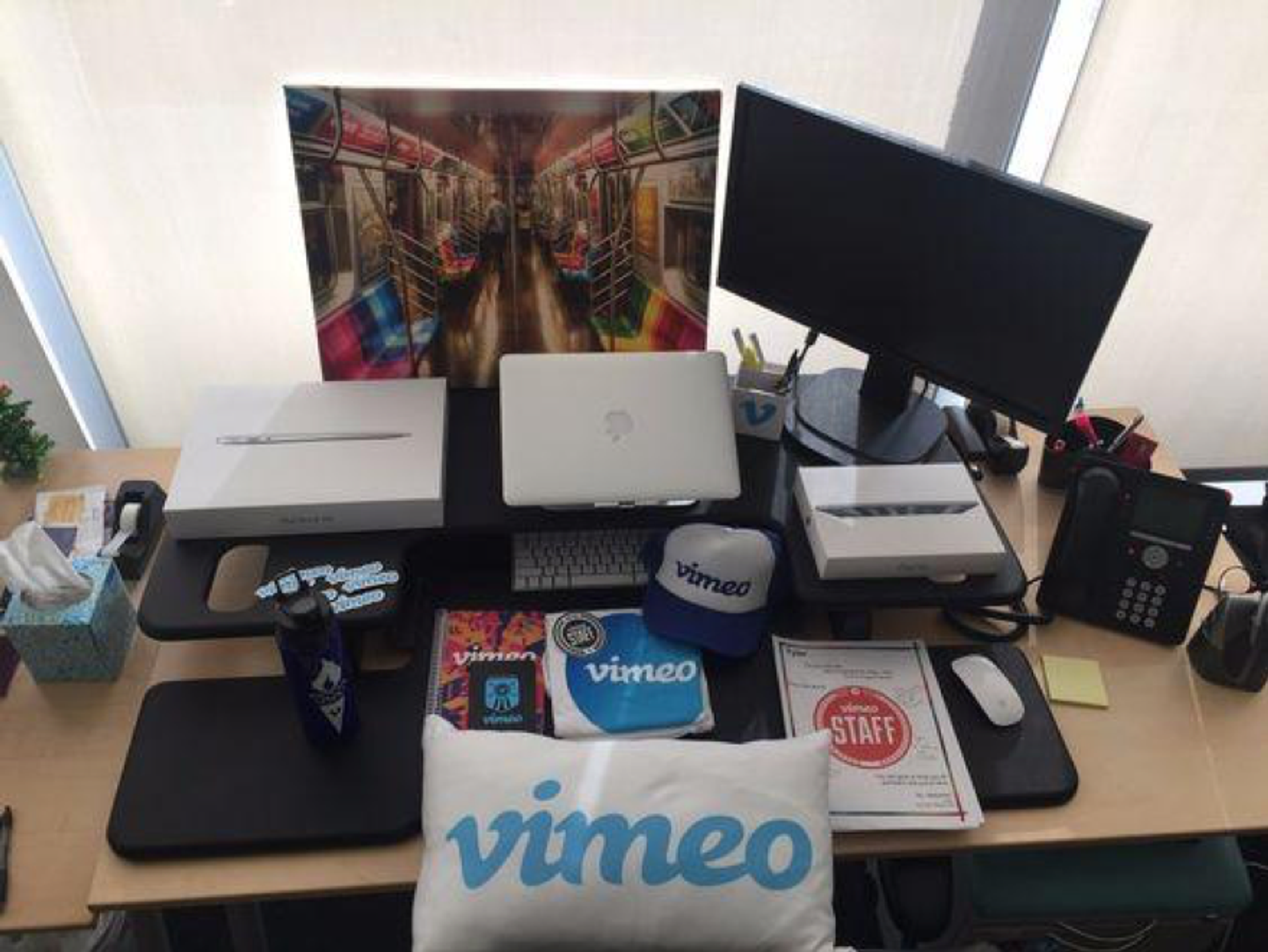
Welcome Kit Vimeo – Source: Typelane
Employee onboarding: basic rules
Remember that in remote working conditions a person faces the fear of being left out of the team. Therefore, it is important to enrich the employee onboarding and adaptation, but without overdoing it.
Onboarding Checklist for the remote work
The following are some of the elements that should be present in an employee onboarding process checklist:
- Help with documentation and new hire paperwork. In a remote environment, it is necessary to maintain an electronic document flow. Make sure you have processes in place for the creation of electronic signatures, instructions for onboarding new employees, storage of HR documents and templates, and employee access to all relevant files. To achieve this, employee onboarding software solutions are the best alternative. This will save time for both the employer and the new hires: there will be no need to spend resources in the future searching for and sending copies of files, everything needed will already be stored in the system in digitized form.
- The first meeting with the department. As part of the onboarding checklist, consider organise a general meeting on the second or third day of work to give the new employee some time to settle in, resolve contractual issues and familiarise themselves with responsibilities.
- Getting to know the mentor. It is recommended that a call or a meeting be held on the first day to inform the new hires who to contact for any questions regarding their adaptation to the work team during the onboarding process.
- Getting to know the company's FAQ and knowledge base. It's great if all the material is collected in one place and divided into separate folders by department. An Employee Handbook is the best alternative.
- Passing through onboarding training. This is a very important process if a company wants to train new hires on the nuances of its products, projects and services. A good approach to this is to prepare a program with a textual description or a video explaining the work process. At the end, practical exercises can be sent to the employee to see how he/she assimilates the new information, and at the end you always receive feedback.
- Work plan (KPI) for the probationary period. At the first meeting with the line manager or during the first week, the new employees should receive a plan against which his or her performance during the probationary period will be evaluated.
- Completion of the probationary period and OKR assignment. Regardless of the length of the probationary period, after the end of it, a meeting with the line manager needs to be scheduled, where the new employees will receive clear feedback on their performance and, in case of success, the tasks and objectives set for the next probationary period.
Employee onboarding process trends: what's important to keep in mind
- Buddy programs. HCI studied that 87% of employees are more successful if they have a mentor, a so-called buddy. This is a mentor who is assigned to an employee for an initial period - for example, 1 month. Once a week, the person is assigned 1-on-1 with their "buddy" where they share their first successes. It is important to distinguish between "line manager" and "buddy". Preferably, these should be different people.
- Simplifying processes. Sapling has published a report estimating that the new hires undertakes an average of 54 activities in their first week on the job, all of which are related to fitting in. It can be difficult to cope with everything at once, and outside the office you have to do it yourself. This is why the trend towards automating processes and searching for programs for automated workflows is growing.
- Cross-boarding under stressful conditions. According to HCI itself, employee onboarding is as important as the creation of a new job. In a remote environment, the need for employees to take on new tasks has been raised. Here, too, it is important to carry out adaptation programs and to take into account advice on how to simplify the entire process.
- Identify innovative ways to maintain contact. Find creative ways to establish contact with the new employee who is not in the office and occasional contact with co-workers no longer exists in the remote working scheme. Managers need to devise and think of new methods to maintain contact. Try to organise informal meetings, and coffee chats, where employees have the opportunity to meet new co-workers and potential mentors. Modelling by leaders is important to create the kind of behaviours they want employees to develop.
Useful programs for organizing employees' work
The first thing that facilitates communication, of course, is Google services : we cannot imagine life without Google Drive folders, the calendar and scheduled meetings in Meets, as an alternative to Zoom.
Slack , a handy tool for the corporate communication channel, comes to the rescue. Here you can organise a shared space with different channels per department and personal messages between colleagues.
We recommend ClickUp for assign tasks, a service where you can see the company's goal tree. The advantage of the program is that you can immediately feel part of the important process: everything is open and accessible. We also recommend Asana, Todoist and Wrike.
The value of Employee Onboarding Software:
the PeopleForce case
In addition to simple tools, it is necessary to use effective onboarding software to automate the HR processes. This is how this process is built into our team:
The PeopleHR module makes it easy to set up onboarding in just a few clicks. Here you can:
- Plan different onboarding programs for staff of different categories and departments.
- Assign activities to the days after hiring and define when the onboarding tasks should be completed.
- Add links to videos, training materials, etc. to the program.
- Keep track of new hires completed tasks.
- View employee progress in real time.
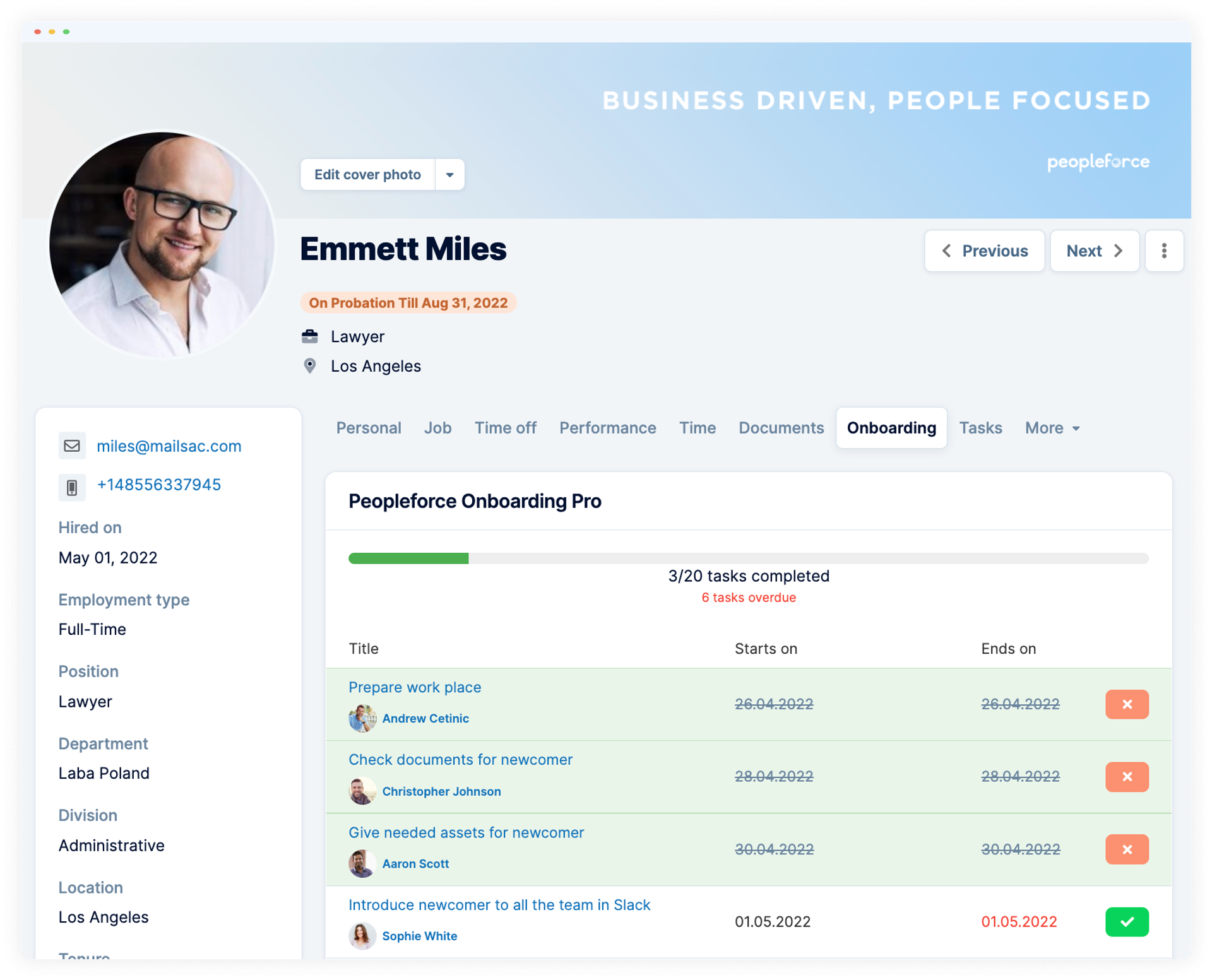
In our onboarding software, you will find:
- Product videos and task practice.
The new hires gets to know the PeopleForce onboarding tool from the inside: not only does he or she occupy your office, but also goes through a special training program.
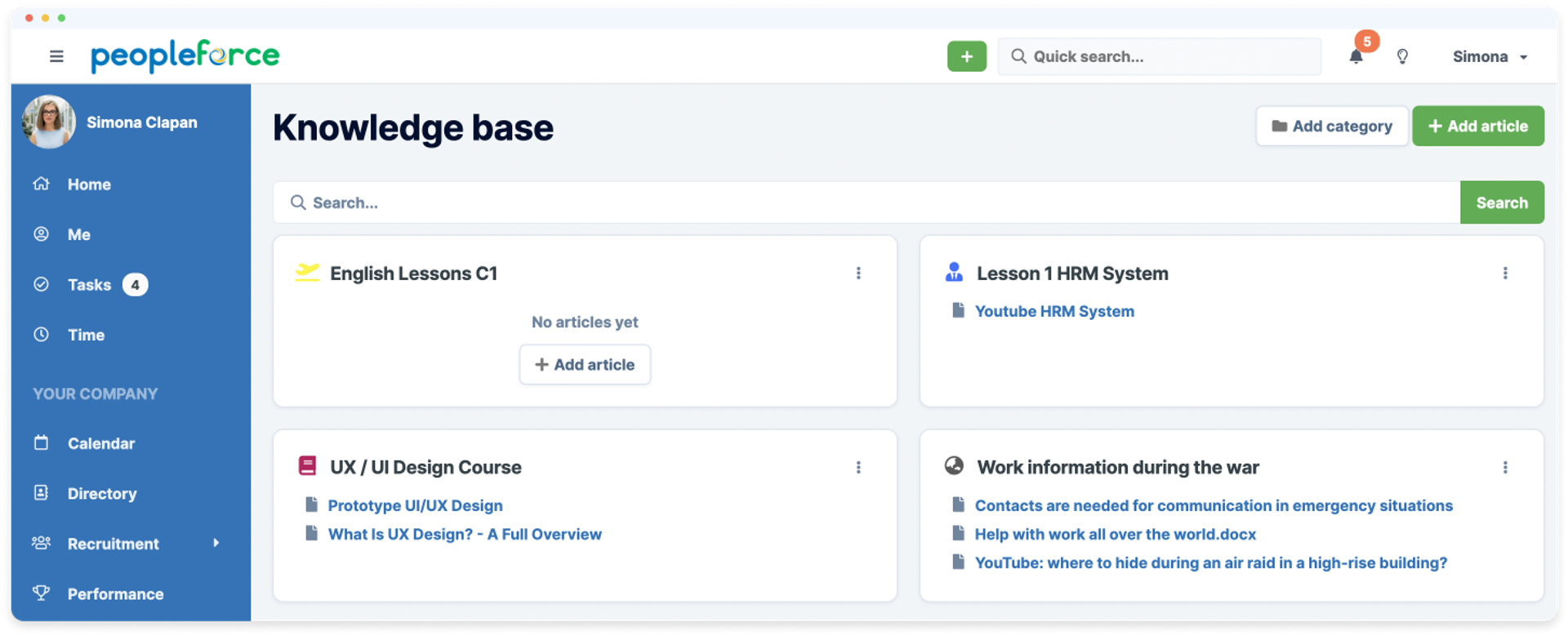
" Joining PeopleForce is simple: you fill in your details, familiarise yourself with the material database and then learn the product. The process is as follows: you watch a video showing each action on the teacher's screen, and you try to do the same in the system itself. The first day I registered a prototype of my company and had fun adding pictures of my favourite actors to the avatars of the virtual employees. These are small things, but they help you learn without stress".
Maria is a new employee in the Marketing Department of PeopleForce.
- Employee data and personal account
In the employee area you can view holiday details, view company information, news and find contacts. Look for the employee account in our HR software.
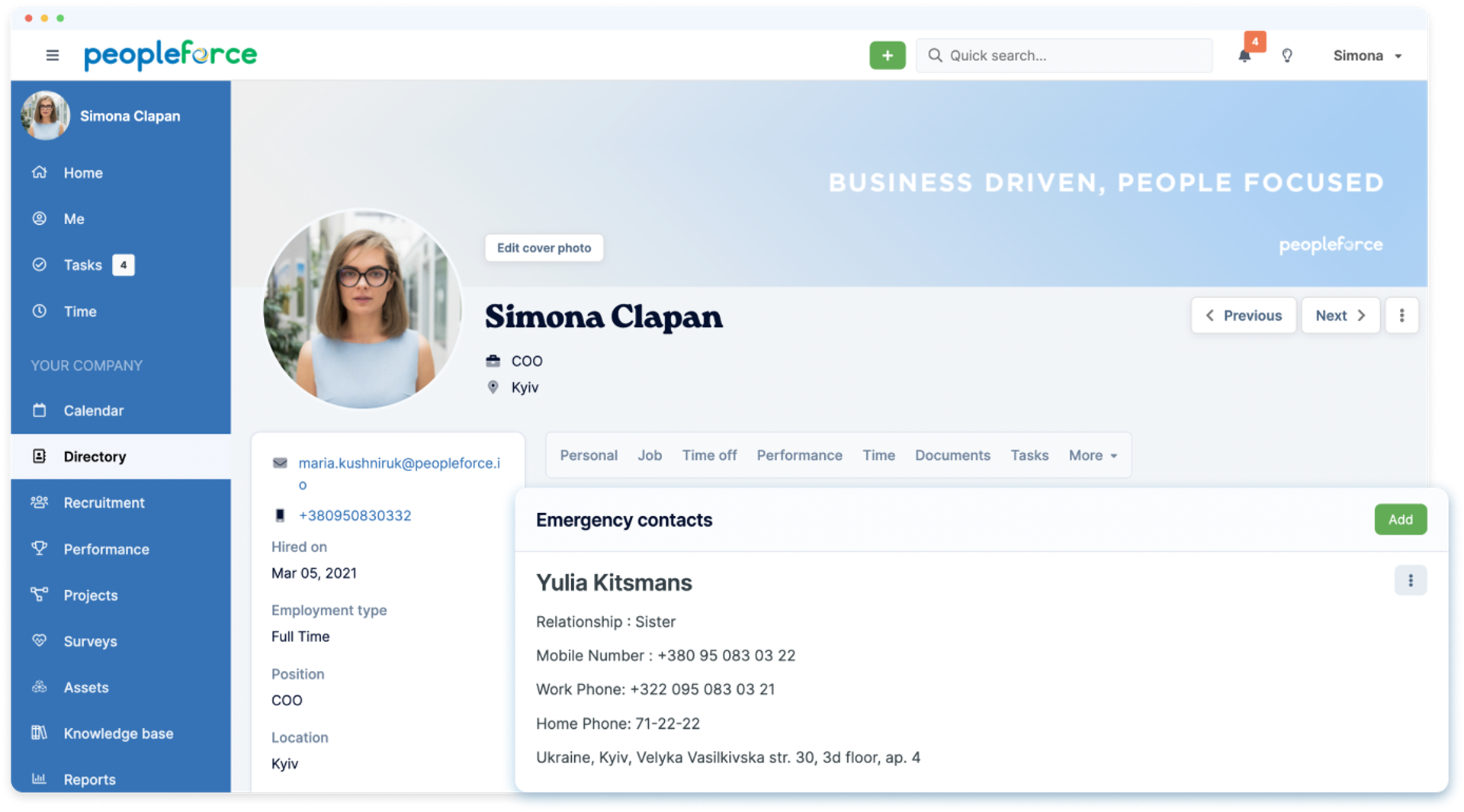
"At last I can see how my holiday or weekend leave is accrued. In my previous job, I had to approach an HR department, who then looked for an accountant for a long time, and together they tried to decipher the Excel table with the days off. Now it's all on the same page: you can log in and look at it at any time."
Anton, a new employee in the PeopleForce development department.
- Personal goals
Goals can be set for the new employees during or after their probationary period. All 1:1 meetings are also entered into the system: you receive a notification before and after the meeting, with notes about the meeting. 1:1 meeting in PeopleForce.
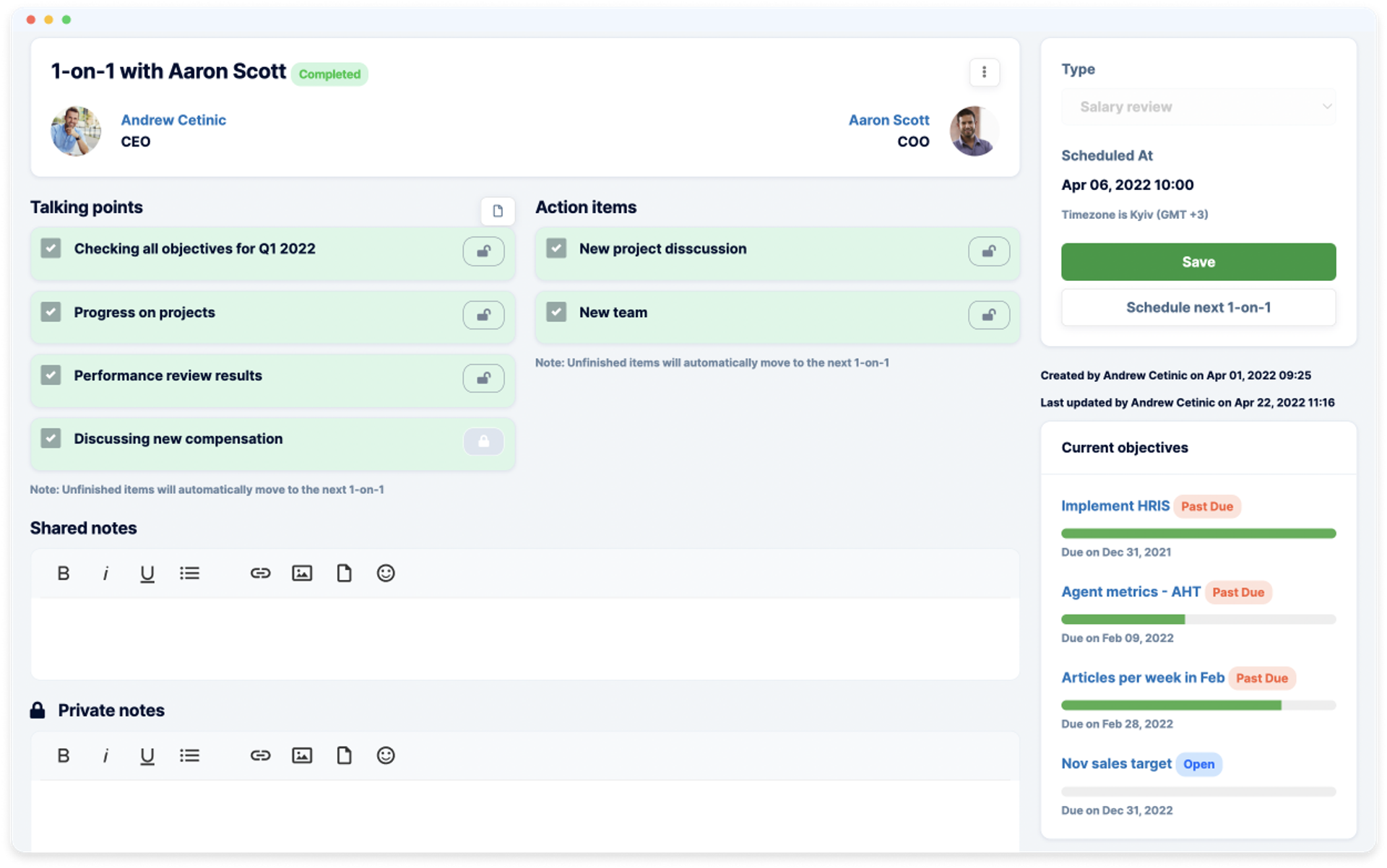
"Convenient for those who take the time to monitor performance. If transparency and engagement are part of your corporate culture, you can automate them and no longer worry about fragmented processes."
Anastasia Efimenko, COO of PeopleForce.
Why can't we forget about onboarding?
New employees should have answers to the following questions so that they know how to fulfil their job expectations: What do we believe in this company? What is my role? What do I have to achieve? Who are my colleagues?
Taking all data and statistics into account, we conclude that a good employee onboarding is a step towards creating a transparent and clear corporate culture in which people are valuable, regardless of the work format. Therefore, do not forget to take the following recommendations into account:
- Communicate face-to-face to maintain personal contact.
- Be clear with expectations so that the new employee understands what is expected of him/her.
- Ask the team to get involved in the employee's life: write to them, ask them about things, offer help.
- Organise a co-working space for those who, due to family or personal circumstances, find it difficult to be at home.
- Automate and adapt the new employee onboarding process to the new realities. It is a good idea to keep the onboarding process under control. Worry about programs and a new employee onboarding solution that will make life easier for both parties.
Frequently Asked Questions
What are the phases of onboarding?
The stages of onboarding can be divided, for example, as follows: pre-onboarding, first week, first month, three months, etc. Each company can define the stages over a period of up to six months or more, depending on its culture and resources.
What is the onboarding process of new employees?
This is the strategic process of integrating a new employee into the company and the team, with the aim of achieving their engagement and permanence. It seeks to obtain a first positive employee experience, get to know the corporate values and objectives, compare expectations and real responsibilities, among others.
What is a good onboarding process?
Effective onboarding is about delivering on the promises made during recruitment and preparing new hires to integrate into the work team and perform well. When this is achieved, employees feel a sense of belonging, learn what defines their success and become committed to the company.
How can employee onboarding experience be improved?
The role of leaders and Hiring Managers is critical; they must optimise their approach to ensure that new employees can form the partnerships and connections necessary to get the job done. Feedback should be frequent and specific to gather information and take corrective action if necessary.
How long should onboarding last?
HR professionals generally agree that the employee onboarding process should last at least three months. However, this can vary according to the company's needs, so the process can be extended to 6 months or even up to a year. There has even been evidence of a favourable increase in employee retention in longer onboarding processes.
Get started with PeopleForce today
Automate your HR routine to create a high performance culture in your company. PeopleForce is your best HRM alternative to stay business driven but people focused.

Recent articles
Top 25 methods of hiring pre-screening
Pre-screening is a preliminary assessment of the professionals with whom we will have to collaborate with. In this case, we are only interested in working skills/hard skills.
What is an HRMS? - test
An HRMS is a CRM system focused on your own people, not your customers, with tools and supporting technologies to help you attract, engage and retain the right people for your company's success.
PeopleForce announces $2 million in seed funding led by Pracuj Ventures
We are thrilled to announce a $2 million follow-on investment led by Pracuj Ventures

